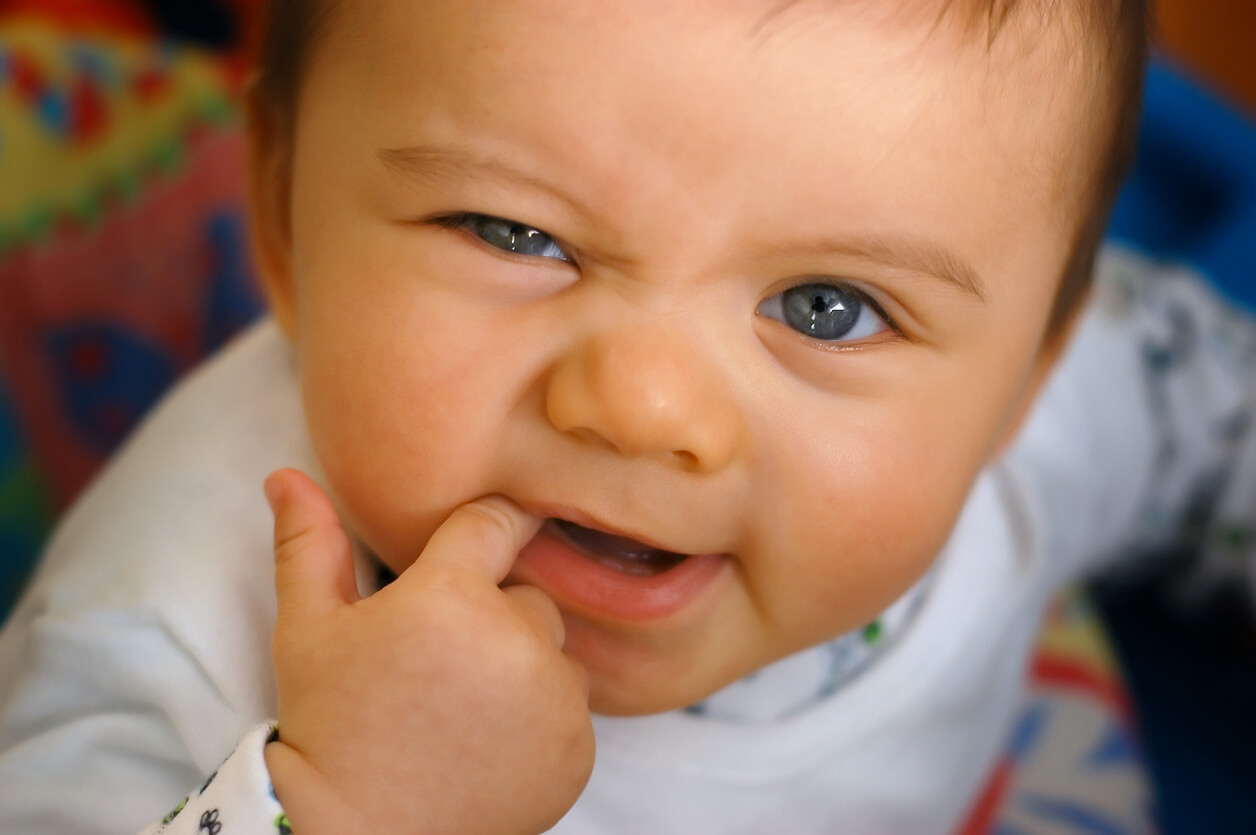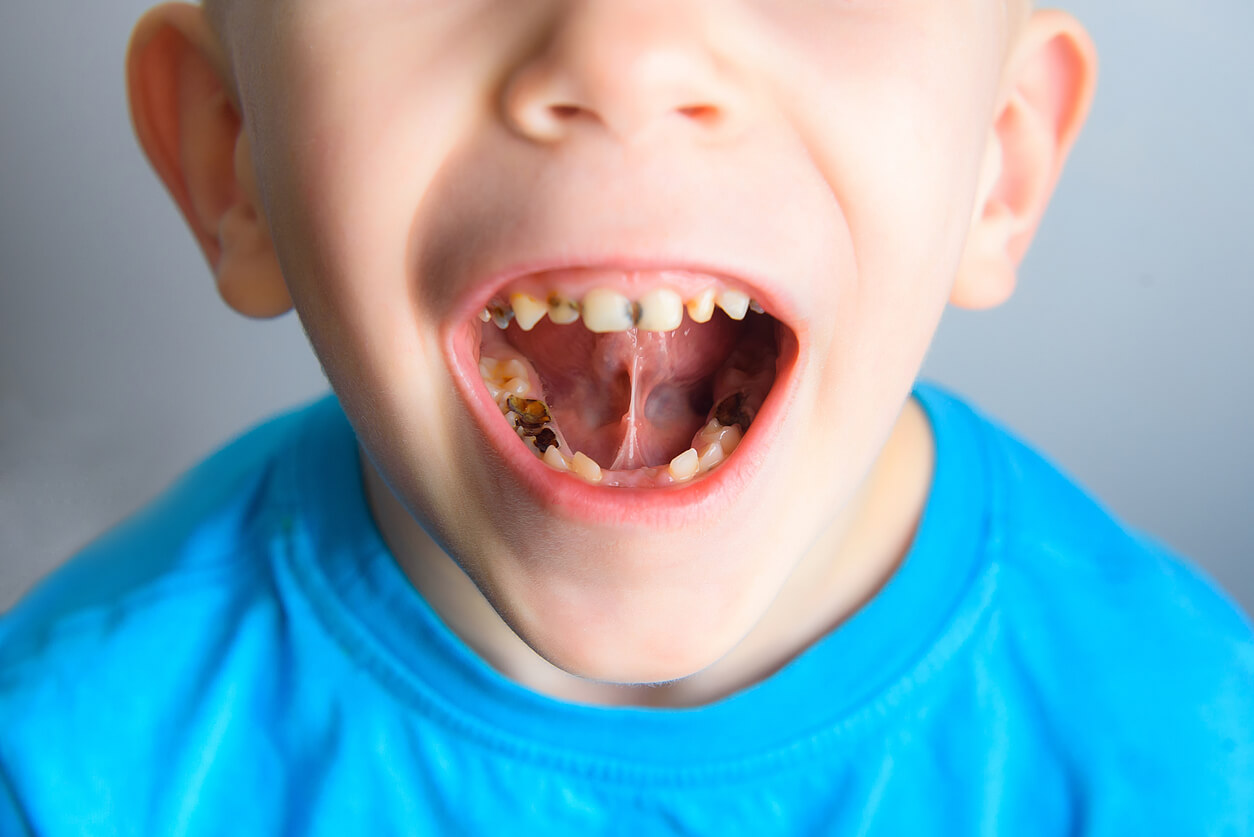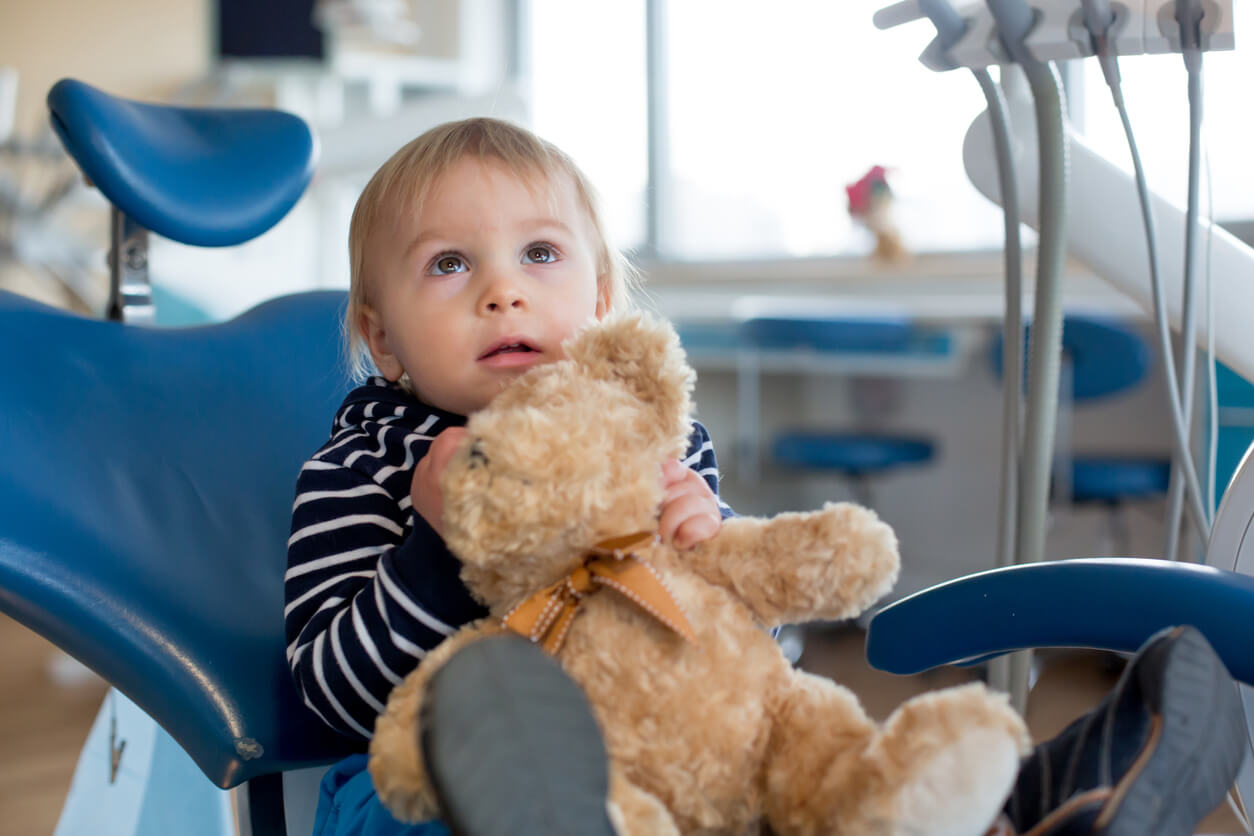7 Frequently Asked Questions About Baby Teeth

The appearance of the first teeth in the baby’s mouth is a long-awaited moment for parents. But with their eruption, many uncertainties can also arise. There are common doubts about the role of these elements in the child’s mouth, whether they influence the final dentition, and whether they can become diseased. There is even some confusion regarding their care. Adults play a key role in preserving children’s health. Therefore, in this article, we’ll answer the 7 most frequently asked questions about baby teeth.
1. When do baby teeth begin to erupt?
Baby teeth begin to form during intrauterine life, from the first weeks of gestation. Both temporary and permanent teeth develop inside the maxillary bones until they erupt.
In general, at around 6 months of age, the first baby teeth appear. But this is an estimated age, as each child has their own growth rhythm.
The teething process happens in a progressive manner and with a particular sequence: the lower incisors are the first to appear, followed by the upper incisors. Next come the first molars, then the canines, and finally the second molars.
Although the order mentioned is the most common, it can also vary from one child to another. But between 2 and a half and 3 years of age, most children complete the eruption of their baby teeth and have their 20 teeth in their mouths.
2. How to alleviate discomfort during dental eruption?

This is also one of the most frequent questions about baby teeth, as the process of tooth eruption can be upsetting for some infants. Babies tend to be irritable, cry easily, drool excessively, and put everything they find in their mouths.
To help little ones to go through this period more comfortably, it’s a good idea to offer them some cool object, such as teethers, spoons, or a cloth refrigerated in the refrigerator. Massaging the gums with clean fingers can also soothe them.
If babies are already in the complementary feeding stage, they can be offered semi-solid textures and fresh foods to soothe sore gums. This should always be done under supervision in order to avoid accidents.
In cases where the baby is very irritable and listless, it’s best to consult with their pediatrician to evaluate the use of an anti-inflammatory.
3. When do baby teeth fall out?
How long will the baby teeth last in the mouth is another of the frequent questions about baby teeth. While it’s true that they’ll fall out at some point, baby teeth will accompany the child for several years.
Between 5 and 7 years of age, the stage of tooth replacement begins, in which the baby teeth become loose, fall out, and are replaced by their definitive substitutes. This period will occur progressively until it culminates around 12 or 13 years of age.
The first baby teeth to be replaced are the lower incisors and then the upper incisors, the molars (which are replaced by the premolars), and the canines.
It’s worth clarifying that, behind the temporary molars, around 6 years of age the first definitive molars erupt without any pieces falling out. And at 12 years of age, behind these, the second molars will erupt.
At around 12 or 13 years of age, the definitive dentition is completed with 28 teeth in the mouth. This doesn’t take into account the eruption of the third molars or wisdom teeth, which erupt after the age of 17 and thus complete the 32 permanent teeth.
4. What’s the function of baby teeth?
One of the most frequently asked questions about baby teeth is related to the role they play in children’s mouths. Many adults believe that because they’ll fall out later, their permanence and care aren’t important.
In reality, this thought is incorrect because temporary teeth are fundamental for the correct development of infants.
Baby teeth are involved in feeding, as they help the child to chew and swallow correctly. They’re also involved in the pronunciation of several phonemes, which is essential for the development of speech.
Although the appearance of the smile may seem like a minor concern, the truth is that having broken or stained teeth also has a negative influence on children’s self-esteem. Teasing from peers or embarrassment about their appearance can affect their social relationships.
The baby teeth also hold the space needed for the eruption of the permanent teeth and act as a guide during the eruption process. The permanent elements find their place in the dental arch thanks to them, thus avoiding malpositioning or bite problems.
5. What diseases affect baby teeth?

The main problem that baby teeth can have is dental cavities. In fact, it’s one of the most common diseases in children.
Cavities are the destructive process of the hard tissues of the teeth. The metabolism of sugars in the diet causes acids that demineralize their surface and wear them down.
The presence of bacterial plaque as a consequence of inadequate dental hygiene and a diet rich in sweets are the main factors in this disease.
For this reason, it’s advisable to avoid foods with a high sugar content, such as sweets, packaged juices, pastries, and soft drinks.
It’s also best to prevent children from falling asleep with a bottle in their mouths, as the sugar in milk remains adhered to the tooth surfaces for a long time. This increases the risk of developing an aggressive form of the disease, called early childhood caries.
In addition, to avoid the transmission of pathogenic bacteria from parents’ mouths to children’s mouths, it’s important not to blow on your baby’s food, not to use the same spoon, and not to clean their pacifier with your own saliva.
6. When should you start cleaning baby teeth?
Oral hygiene in young children is of utmost importance to keep baby teeth healthy. Oral cleaning should begin as early as the first days of life.
When teeth haven’t yet erupted, the mouth can be cleaned with a small clean, damp cloth placed around the finger or a rubber thimble specially designed for this purpose. The gums are gently rubbed to remove milk residue and to get the child used to the cleaning routine. And during the teething period, this also helps to soothe discomfort.
When the first baby dental piece erupts, you need to start using a special baby toothbrush.
Parents should take care of dental hygiene at least 2 times a day. Also, they should use a small portion of fluoride toothpaste, which varies according to the child’s age and ability to spit. To avoid fluorosis, you need to choose the best product for each child, according to your child’s pediatric dentist.
At around 6 and 8 years of age, children can already begin to brush by themselves. In any case, an adult should continue to supervise the child so that it’s done properly.
7. When should you visit the dentist?
It’s best to visit a pediatric dentist for the first time before the baby’s first birthday. This way, the professional can evaluate the overall condition of the child’s mouth and follow the eruption process. In addition, the dentist provides information and advice to parents on the care of their child’s mouth.
Visits every 6 months are ideal in order to promote the bond between the child and the professional and to detect any problems early on.
Also, the professional should be consulted when any injury or discomfort appears in the child’s mouth, when a blow occurs in the oral cavity, or when stains are observed on the teeth.

Children’s health is the parents’ responsibility
Baby teeth allow children to eat, speak, and interact normally. They also play a fundamental role in the eruption of permanent teeth.
That’s why taking care of them and keeping them in the mouth until they’re replaced is vital. Having doubts about baby teeth is normal, but with committed and responsible parents, little ones will be able to show off a healthy smile during childhood.
The appearance of the first teeth in the baby’s mouth is a long-awaited moment for parents. But with their eruption, many uncertainties can also arise. There are common doubts about the role of these elements in the child’s mouth, whether they influence the final dentition, and whether they can become diseased. There is even some confusion regarding their care. Adults play a key role in preserving children’s health. Therefore, in this article, we’ll answer the 7 most frequently asked questions about baby teeth.
1. When do baby teeth begin to erupt?
Baby teeth begin to form during intrauterine life, from the first weeks of gestation. Both temporary and permanent teeth develop inside the maxillary bones until they erupt.
In general, at around 6 months of age, the first baby teeth appear. But this is an estimated age, as each child has their own growth rhythm.
The teething process happens in a progressive manner and with a particular sequence: the lower incisors are the first to appear, followed by the upper incisors. Next come the first molars, then the canines, and finally the second molars.
Although the order mentioned is the most common, it can also vary from one child to another. But between 2 and a half and 3 years of age, most children complete the eruption of their baby teeth and have their 20 teeth in their mouths.
2. How to alleviate discomfort during dental eruption?

This is also one of the most frequent questions about baby teeth, as the process of tooth eruption can be upsetting for some infants. Babies tend to be irritable, cry easily, drool excessively, and put everything they find in their mouths.
To help little ones to go through this period more comfortably, it’s a good idea to offer them some cool object, such as teethers, spoons, or a cloth refrigerated in the refrigerator. Massaging the gums with clean fingers can also soothe them.
If babies are already in the complementary feeding stage, they can be offered semi-solid textures and fresh foods to soothe sore gums. This should always be done under supervision in order to avoid accidents.
In cases where the baby is very irritable and listless, it’s best to consult with their pediatrician to evaluate the use of an anti-inflammatory.
3. When do baby teeth fall out?
How long will the baby teeth last in the mouth is another of the frequent questions about baby teeth. While it’s true that they’ll fall out at some point, baby teeth will accompany the child for several years.
Between 5 and 7 years of age, the stage of tooth replacement begins, in which the baby teeth become loose, fall out, and are replaced by their definitive substitutes. This period will occur progressively until it culminates around 12 or 13 years of age.
The first baby teeth to be replaced are the lower incisors and then the upper incisors, the molars (which are replaced by the premolars), and the canines.
It’s worth clarifying that, behind the temporary molars, around 6 years of age the first definitive molars erupt without any pieces falling out. And at 12 years of age, behind these, the second molars will erupt.
At around 12 or 13 years of age, the definitive dentition is completed with 28 teeth in the mouth. This doesn’t take into account the eruption of the third molars or wisdom teeth, which erupt after the age of 17 and thus complete the 32 permanent teeth.
4. What’s the function of baby teeth?
One of the most frequently asked questions about baby teeth is related to the role they play in children’s mouths. Many adults believe that because they’ll fall out later, their permanence and care aren’t important.
In reality, this thought is incorrect because temporary teeth are fundamental for the correct development of infants.
Baby teeth are involved in feeding, as they help the child to chew and swallow correctly. They’re also involved in the pronunciation of several phonemes, which is essential for the development of speech.
Although the appearance of the smile may seem like a minor concern, the truth is that having broken or stained teeth also has a negative influence on children’s self-esteem. Teasing from peers or embarrassment about their appearance can affect their social relationships.
The baby teeth also hold the space needed for the eruption of the permanent teeth and act as a guide during the eruption process. The permanent elements find their place in the dental arch thanks to them, thus avoiding malpositioning or bite problems.
5. What diseases affect baby teeth?

The main problem that baby teeth can have is dental cavities. In fact, it’s one of the most common diseases in children.
Cavities are the destructive process of the hard tissues of the teeth. The metabolism of sugars in the diet causes acids that demineralize their surface and wear them down.
The presence of bacterial plaque as a consequence of inadequate dental hygiene and a diet rich in sweets are the main factors in this disease.
For this reason, it’s advisable to avoid foods with a high sugar content, such as sweets, packaged juices, pastries, and soft drinks.
It’s also best to prevent children from falling asleep with a bottle in their mouths, as the sugar in milk remains adhered to the tooth surfaces for a long time. This increases the risk of developing an aggressive form of the disease, called early childhood caries.
In addition, to avoid the transmission of pathogenic bacteria from parents’ mouths to children’s mouths, it’s important not to blow on your baby’s food, not to use the same spoon, and not to clean their pacifier with your own saliva.
6. When should you start cleaning baby teeth?
Oral hygiene in young children is of utmost importance to keep baby teeth healthy. Oral cleaning should begin as early as the first days of life.
When teeth haven’t yet erupted, the mouth can be cleaned with a small clean, damp cloth placed around the finger or a rubber thimble specially designed for this purpose. The gums are gently rubbed to remove milk residue and to get the child used to the cleaning routine. And during the teething period, this also helps to soothe discomfort.
When the first baby dental piece erupts, you need to start using a special baby toothbrush.
Parents should take care of dental hygiene at least 2 times a day. Also, they should use a small portion of fluoride toothpaste, which varies according to the child’s age and ability to spit. To avoid fluorosis, you need to choose the best product for each child, according to your child’s pediatric dentist.
At around 6 and 8 years of age, children can already begin to brush by themselves. In any case, an adult should continue to supervise the child so that it’s done properly.
7. When should you visit the dentist?
It’s best to visit a pediatric dentist for the first time before the baby’s first birthday. This way, the professional can evaluate the overall condition of the child’s mouth and follow the eruption process. In addition, the dentist provides information and advice to parents on the care of their child’s mouth.
Visits every 6 months are ideal in order to promote the bond between the child and the professional and to detect any problems early on.
Also, the professional should be consulted when any injury or discomfort appears in the child’s mouth, when a blow occurs in the oral cavity, or when stains are observed on the teeth.

Children’s health is the parents’ responsibility
Baby teeth allow children to eat, speak, and interact normally. They also play a fundamental role in the eruption of permanent teeth.
That’s why taking care of them and keeping them in the mouth until they’re replaced is vital. Having doubts about baby teeth is normal, but with committed and responsible parents, little ones will be able to show off a healthy smile during childhood.
All cited sources were thoroughly reviewed by our team to ensure their quality, reliability, currency, and validity. The bibliography of this article was considered reliable and of academic or scientific accuracy.
- Ayala Pérez, Y., Carralero Zaldívar, L. D. L. C., & Leyva Ayala, B. D. R. (2018). La erupción dentaria y sus factores influyentes. Correo Científico Médico, 22(4), 681-694.
- Umaña, A. P., Meza, B. Y. C., Barco, M. G., & Hernandez, J. A. (2017, September). CRONOLOGÍA DE LA ERUPCIÓN DENTARIA EN UN GRUPO DE CAUCASOIDES. In XIX Simposio de Investigaciones en salud” Autonomía, Financiación y Calidad.
- Aimituma Tairo, K. (2019). Desarrollo y erupción dentaria.
- Pin Vélez, J. A. (2020). Prevalencia de caries en dientes temporales (Bachelor’s thesis, Universidad de Guayaquil. Facultad Piloto de Odontología).
- Duque de Estrada Riverón, J., Rodríguez Calzadilla, A., Coutin Marie, G., & Riveron Herrera, F. (2003). Factores de riesgo asociados con la enfermedad caries dental en niños. Revista Cubana de estomatología, 40(2), 0-0.
- Morán Vera, H. E. (2021). Nivel de conocimiento de los padres sobre la importancia de la dentición temporal (Bachelor’s thesis, Universidad de Guayaquil. Facultad Piloto de Odontología).
- Ruiz Intriago, B. J. (2020). Importancia de la preservación de dientes temporarios en niños (Bachelor’s thesis, Universidad de Guayaquil. Facultad Piloto de Odontología).
- Pillaca Maricella, M. (2017). Desarrollo de la dentición fase intrauterina, erupción evolución de las denticiones temporales y permanentes.
- Minaya Ramos, G. G. (2021). Factores de riesgo de caries en dentición primaria (Bachelor’s thesis, Universidad de Guayaquil. Facultad Piloto de Odontología).
- Capelo Ríos, D. G. (2019). Nivel de conocimiento de padres de familia sobre higiene dental de niños con diagnóstico de caries (Bachelor’s thesis, Universidad Nacional de Chimborazo, 2019).
- Páez, C. A. V., Castillo, E. L. T., & Ávila, J. A. T. (2021). Higiene bucal como factor determinante en incidencia de caries dental niños de 6 a 12 años. RECIMUNDO, 5(1), 227-240.
This text is provided for informational purposes only and does not replace consultation with a professional. If in doubt, consult your specialist.








